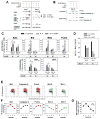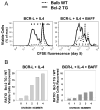A p53 axis regulates B cell receptor-triggered, innate immune system-driven B cell clonal expansion
- PMID: 22611237
- PMCID: PMC3370112
- DOI: 10.4049/jimmunol.1103037
A p53 axis regulates B cell receptor-triggered, innate immune system-driven B cell clonal expansion
Abstract
Resting mature human B cells undergo a dynamic process of clonal expansion, followed by clonal contraction, during an in vitro response to surrogate C3d-coated Ag and innate immune system cytokines, IL-4 and BAFF. In this study, we explore the mechanism for clonal contraction through following the time- and division-influenced expression of several pro- and anti-apoptotic proteins within CFSE-labeled cultures. Several findings, involving both human and mouse B cells, show that a mitochondria-dependent apoptotic pathway involving p53 contributes to the high activation-induced cell death (AICD) susceptibility of replicating blasts. Activated B cell clones exhibit elevated p53 protein and elevated mRNA/protein of proapoptotic molecules known to be under direct p53 transcriptional control, Bax, Bad, Puma, Bid, and procaspase 6, accompanied by reduced anti-apoptotic Bcl-2. Under these conditions, Bim levels were not increased. The finding that full-length Bid protein significantly declines in AICD-susceptible replicating blasts, whereas Bid mRNA does not, suggests that Bid is actively cleaved to short-lived, proapoptotic truncated Bid. AICD was diminished, albeit not eliminated, by p53 small interfering RNA transfection, genetic deletion of p53, or Bcl-2 overexpression. DNA damage is a likely trigger for p53-dependent AICD because susceptible lymphoblasts expressed significantly elevated levels of both phosphorylated ataxia telangiectasia mutated-Ser(1980) and phospho-H2AX-Ser(139). Deficiency in activation-induced cytosine deaminase diminishes but does not ablate murine B cell AICD, indicating that activation-induced cytosine deaminase-induced DNA damage is only in part responsible. Evidence for p53-influenced AICD during this route of T cell-independent clonal expansion raises the possibility that progeny bearing p53 mutations might undergo positive selection in peripherally inflamed tissues with elevated levels of IL-4 and BAFF.
Figures









Similar articles
-
Effects of prostaglandin E2 on p53 mRNA transcription and p53 mutagenesis during T-cell-independent human B-cell clonal expansion.FASEB J. 2014 Feb;28(2):627-43. doi: 10.1096/fj.13-237792. Epub 2013 Oct 21. FASEB J. 2014. PMID: 24145719 Free PMC article.
-
IL-4 regulates Bim expression and promotes B cell maturation in synergy with BAFF conferring resistance to cell death at negative selection checkpoints.J Immunol. 2014 Jun 15;192(12):5761-75. doi: 10.4049/jimmunol.1300749. Epub 2014 May 16. J Immunol. 2014. PMID: 24835393
-
Bax/Bak activation in the absence of Bid, Bim, Puma, and p53.Cell Death Dis. 2016 Jun 16;7(6):e2266. doi: 10.1038/cddis.2016.167. Cell Death Dis. 2016. PMID: 27310874 Free PMC article.
-
What do we know about the mechanisms of elimination of autoreactive T and B cells and what challenges remain.Immunol Cell Biol. 2008 Jan;86(1):57-66. doi: 10.1038/sj.icb.7100141. Epub 2007 Nov 20. Immunol Cell Biol. 2008. PMID: 18026176 Review.
-
B-cell stage and context-dependent requirements for survival signals from BAFF and the B-cell receptor.Immunol Rev. 2010 Sep;237(1):205-25. doi: 10.1111/j.1600-065X.2010.00944.x. Immunol Rev. 2010. PMID: 20727038 Review.
Cited by
-
TLR-9 and IL-15 Synergy Promotes the In Vitro Clonal Expansion of Chronic Lymphocytic Leukemia B Cells.J Immunol. 2015 Aug 1;195(3):901-23. doi: 10.4049/jimmunol.1403189. Epub 2015 Jul 1. J Immunol. 2015. PMID: 26136429 Free PMC article.
-
CD19 Chimeric Antigen Receptor-Exosome Targets CD19 Positive B-lineage Acute Lymphocytic Leukemia and Induces Cytotoxicity.Cancers (Basel). 2021 Mar 19;13(6):1401. doi: 10.3390/cancers13061401. Cancers (Basel). 2021. PMID: 33808645 Free PMC article.
-
BCL2 Protein Progressively Declines during Robust CLL Clonal Expansion: Potential Impact on Venetoclax Clinical Efficacy and Insights on Mechanism.Lymphatics. 2024 Jun;2(2):50-78. doi: 10.3390/lymphatics2020005. Epub 2024 Mar 28. Lymphatics. 2024. PMID: 39664277 Free PMC article.
-
The Proteasome Inhibitor Bortezomib Induces p53-Dependent Apoptosis in Activated B Cells.J Immunol. 2024 Jan 1;212(1):154-164. doi: 10.4049/jimmunol.2300212. J Immunol. 2024. PMID: 37966267 Free PMC article.
-
Cooperation of Oligodeoxynucleotides and Synthetic Molecules as Enhanced Immune Modulators.Front Nutr. 2019 Aug 27;6:140. doi: 10.3389/fnut.2019.00140. eCollection 2019. Front Nutr. 2019. PMID: 31508424 Free PMC article. Review.
References
-
- El Shikh ME, El Sayed RM, Szakal AK, Tew JG. T-independent antibody responses to T-dependent antigens: a novel follicular dendritic cell-dependent activity. J Immunol. 2009;182:3482–3491. - PubMed
-
- Baumgarth N. A two-phase model of B-cell activation. Immunol Rev. 2000;176:171–180. - PubMed
-
- Defrance T, Taillardet M, Genestier L. T cell-independent B cell memory. Curr Opin Immunol. 2011;23:330–336. - PubMed
-
- Mongini PK, Inman JK, Han H, Fattah RJ, Abramson SB, Attur M. APRIL and BAFF promote increased viability of replicating human B2 cells via mechanism involving cyclooxygenase 2. J Immunol. 2006;176:6736–6751. - PubMed
Publication types
MeSH terms
Substances
Grants and funding
LinkOut - more resources
Full Text Sources
Molecular Biology Databases
Research Materials
Miscellaneous

